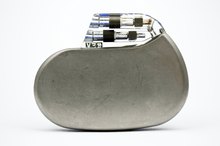What does fact checked mean?
At Healthfully, we strive to deliver objective content that is accurate and up-to-date. Our team periodically reviews articles in order to ensure content quality. The sources cited below consist of evidence from peer-reviewed journals, prominent medical organizations, academic associations, and government data.
- National Heart Lung and Blood Institute: On Pacemakers
- National Heart Lung and Blood Institute: On Pacemakers
The information contained on this site is for informational purposes only, and should not be used as a substitute for the advice of a professional health care provider. Please check with the appropriate physician regarding health questions and concerns. Although we strive to deliver accurate and up-to-date information, no guarantee to that effect is made.
The Effects of Hearing Aids on a Cardiac Pacemaker
How Does a Pacemaker Work?
A pacemaker monitors and helps control your heartbeat by means of a battery, a computerized generator and wires with electrodes or sensors at one end. The generator is powered by the battery, and both are encased in a thin metal box. The wires, at the end of the box, connect the generator to your heart. The pacemaker works by electricity, detecting the electrical activity of your heart and then, if your heart beats abnormally, sending electrical impulses to shock your heartbeat back to normal. It also records the ongoing electrical activity of your heart, so your doctor can monitor both your heart and the pacemaker.
If you are experiencing serious medical symptoms, seek emergency treatment immediately.
- A pacemaker monitors and helps control your heartbeat by means of a battery, a computerized generator and wires with electrodes or sensors at one end.
- The pacemaker works by electricity, detecting the electrical activity of your heart and then, if your heart beats abnormally, sending electrical impulses to shock your heartbeat back to normal.
How Does a Hearing Aid Work?
A hearing aid is a small electronic device that helps to amplify sound. Every electronic hearing aid has a receiver, an amplifier, a battery and electronic circuitry. Most use a remote control device (RCD) to power the hearing aid. There are at least four distinct types of remote control hearing aid devices: FM, electromagnetic induction, tones and infrared to generate a signal.
- A hearing aid is a small electronic device that helps to amplify sound.
Hearing Aids and Pacemakers
The question is whether the electrically powered RCD battery of your hearing aid might cause any interference with, or even completely disrupt, your electrically powered pacemaker. This is of concern, since pacemaker function has been known to react negatively to signals from cell phones, electronic surveillance equipment and other wireless technology.
Product Warnings
Some product literature for hearing aid RCDs carry warnings that say if you have a pacemaker, you should not keep the remote control for your hearing aid near where your pacemaker was surgically installed. A good example of where not to carry your RCD, according to the literature, would be a breast pocket in a shirt or a suit.
Two Studies
The April 2001 edition of the Hearing Journal carried an article by Levi A. Reiter and Jorge Camunas on "Hearing Aid Remote Control Devices and the Pacemaker Patient." In the article, the authors described two studies they had done on hearing aid devices and pacemakers. The first was a study on a single patient at a pacemaker center, with his physician present. The second was an exploration of the effects of several types of RCDs on several varieties of pacemaker, done within an artificial chest cavity. The authors noted that no published studies or research existed at the time of the article on whether pacemaker/hearing aid proximity might create electronic interference that could adversely affect the pacemaker. Four hearing-aid RCDs were chosen for the second study and operated in four different positions: directly over the pacemaker site, over the site but about 18 inches away, one inch away from the atrial lead wire and one inch from the ventricular lead wire. None of the remote control devices tested in either study interfered with the pacing of the heart or the sensing function of the pacemakers in operation, and there was no stoppage or interference with the regularity of pacing with any RCD used 2. There was some loss of remote sensing and measuring of heart data (which your doctor would use to check your heart and the working of the pacemaker), at the one inch distance from the pacemaker with the FM and the electromagnetic induction models. The authors of article concluded that no function of the pacemaker was interfered with by normal operation of any of the RCD devices that were tested in any proximity to the pacemaker. But since remote sensing was affected by FM and electromagnetic induction models, product literature warnings should still be observed as to proximity.
- The April 2001 edition of the Hearing Journal carried an article by Levi A. Reiter and Jorge Camunas on "Hearing Aid Remote Control Devices and the Pacemaker Patient."
- None of the remote control devices tested in either study interfered with the pacing of the heart or the sensing function of the pacemakers in operation, and there was no stoppage or interference with the regularity of pacing with any RCD used 2, at the one inch distance from the pacemaker with the FM and the electromagnetic induction models.
Related Articles
References
- American Speech-Language Hearing Association.org: Hearing Aids
- National Heart Lung and Blood Institute: On Pacemakers
- Kotsakou M, Kioumis I, Lazaridis G, et al. Pacemaker insertion. Ann Transl Med. 2015;3(3):42. doi:10.3978/j.issn.2305-5839.2015.02.06
- American Heart Society. Devices that may interfere with ICDs and pacemakers. Updated September 30, 2016.
- Epstein AE, DiMarco JP, Ellenbogen KA, et al. ACC/AHA/HRS 2008 guidelines for device-based therapy of cardiac rhythm abnormalities: A report of the American College of Cardiology/American Heart Association Task Force on Practice Guidelines (Writing Committee to Revise the ACC/AHA/NASPE 2002 Guideline Update for Implantation of Cardiac Pacemakers and Antiarrhythmia Devices) developed in collaboration with the American Association for Thoracic Surgery and Society of Thoracic Surgeons. J Am Coll Cardiol 2008; 51:e1. doi:10.1016/j.jacc.2008.02.032
- Hauser RG, Hayes DL, Kallinen LM, Cannom DS, Epstein AE, Almquist AK, Song SL, Tyers GF, Vlay SC, Irwin M. Clinical experience with pacemaker pulse generators and transvenous leads: an 8-year prospective multicenter study. Heart Rhythm. 2007 Feb;4(2):154-60. doi:10.1016/j.hrthm.2006.10.009
Writer Bio
Kim Norton wrote for 25 years for an in-house securities research publication. She currently writes articles for Demand Studios that involve medical research, law and senior citizen concerns. She also writes radio advertising copy and opera librettos. A graduate of Westminster Choir College, Norton resides in Bayonne, N.J.









